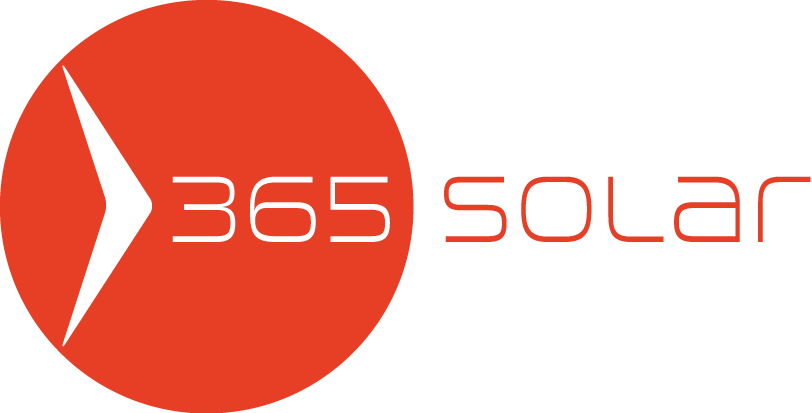FREQUENTLY ASKED QUESTIONS
Find clarity with our Solar Power FAQs—your guide to the perks of solar savings. Let 365 Solar illuminate your switch to clean energy.
Solar energy works by gathering sun energy and turning it into useful electricity. Solar panels, which are composed of photovoltaic (PV) cells, are used to do this. Semiconducting components, like silicon, are used in PV cells to capture solar energy and emit electrons. These electrons generate an electrical current as they move through the PV cells.
The electrical current is then sent through an inverter, which transforms the solar-generated direct current (DC) electricity into the alternating current (AC) electricity used in homes and businesses.
If your system is connected to the grid and you produce more electricity than you require, you can either use the AC electricity to power electrical appliances in your home or send it to the grid. Any extra electricity can be saved in a battery for later use if your system is not connected to the grid.
In conclusion, solar energy is produced by gathering the sun’s energy, turning it into useful electricity, and either using it right away or storing it for later use.
The size of the system, the kind of panels utilised, and the location all affect how much solar panels cost and how much it costs to instal them. A solar panel system typically costs between $3,000 and $10,000 in Australia, with an average price of roughly $7,000. This, of course, may be lower depending on what incentives and Government rebates may be available in your state.
The real cost, however, could be greater or lower depending on the particular requirements of your house or place of business. This is only an estimate. As an illustration, larger systems typically cost more, whereas smaller systems cost less. The complexity of the installation and the location can also affect the cost of installation.
It’s also important to remember that recent technological improvements and more market competition have led to a decrease in the price of solar panels and installation.
Remember that the price of solar panels and their installation is only one component of the total cost of using solar energy. The total cost of ownership for a solar power system should take other expenses like maintenance and repairs into account.
The size of the system, the kind of panels utilised, and the location are just a few of the variables that affect how much electricity solar panels can generate. In Australia, a typical domestic or commercial solar panel system can provide between 3 and 5 kWh of electricity per day for every 1kw installed on your roof.
Solar panels are intended to have a long lifespan, often between 25 and 30 years. The efficiency of the panels may diminish throughout this time, but it usually happens slowly and gradually.
It’s crucial to remember that a number of variables, such as weather, shadowing, and exposure to dust and debris, can have an impact on the longevity and effectiveness of solar panels. Your solar panels’ lifespan and efficiency can be extended with regular upkeep and cleaning.
Overall, solar panels can be a long-term, dependable source of electricity, lowering your carbon footprint and energy expenditures.
The Australian Solar Industry is well regulated to ensure optimal safety for all products, installations and consumers.
All solar panels and inverters that we use and install must, and do, comply with a range of standards to maximise protection and reliability. We will not consider any less for our clients and we’ll never compromise the safety and quality of your systems.
Our team remains up to date on the latest safety requirements and our designs and installations for Solar PV Systems are ensured to comply. All our accredited installers are qualified electricians who have successfully completed additional training and assessment in the installation of Solar PV Systems.
To ensure that your system in running safely and effectively for many years, you will need to maintain it correctly, be sure to speak to us about upkeep procedures for more details.
The suitability of your home or business for solar panels depends on several factors, including:
Roof orientation: The ideal orientation for solar panels is north-facing, as this provides the greatest exposure to the sun. East- and west-facing roofs can also be suitable, but they will produce less energy than a north-facing roof. South-facing roofs are generally not suitable for solar panels.
Roof space: The size of your roof will determine the number of panels you can install, which will in turn determine the amount of energy you can generate.
Shading: Shadows from nearby trees, buildings, or other structures can significantly reduce the efficiency of your solar panels. If your roof is frequently shaded, it may not be suitable for solar panels.
Electrical infrastructure: You will need to have an electrical system in place that is capable of supporting a solar panel system. You may also need to upgrade your electrical system to support the additional load.
Location: The amount of sunlight your location receives will have a significant impact on the amount of energy your solar panels can generate. Generally, areas with more sunlight will have higher energy yields.
If you’re considering installing solar panels, it’s best to have one of our professionals assess your home to determine its suitability and the best options for your specific needs. This will help ensure that you get the most out of your investment in solar power.
Solar energy has a number of advantages, including:
Savings: Solar energy can help you save money by giving you access to a clean, renewable energy source that you can use to power your house or place of business. The financial savings from using solar energy can pile up over time.
Environmentally friendly: Solar energy is a clean, renewable source of energy that doesn’t release any damaging pollutants or glasshouse gases. You may lessen your carbon footprint and contribute to environmental protection by using solar electricity.
Grid independence: Solar energy systems can offer an energy source that is independent of the grid, allowing you more control over your energy supply and boosting your energy security.
Increased property value: Due to the cost savings, environmental advantages, and increased energy security that solar panel systems provide, homes and businesses with them are sometimes thought to be more valuable than those without.
Low upkeep: Solar panel systems are made to last for many years and require very little maintenance. Typically, all that is required to keep your system functioning properly is routine cleaning and sporadic inspections.
Overall, solar energy is a wise investment that can benefit the environment and your wallet in the long run.
Your solar panel system will continue to generate electricity during a power outage for as long as the sun is out. However, if the power outage is extensive, it’s likely that it will also impact your neighborhood’s electrical system, which will prevent you from using the electricity your solar panels produce.
Many homeowners decide to instal a battery storage system coupled with a solar system storage back-up device in order to solve this problem. This gives you a dependable supply of energy even when the grid is down by enabling you to store the extra energy your solar panels produce during the day and use it during a power outage.
It’s also crucial to keep in mind that certain solar panel systems come with a backup generator that can supply electricity in case of an extended power outage. This alternative can offer more security and energy supply, but it is typically more expensive than a battery storage system.
In conclusion, the efficiency of your solar panel system during a power outage will be based on the particular system you have placed and if you have included battery storage or a backup generator.
There are a number of factors which will determine how much money a household will save on their power bills in going solar. These factors include:
- Energy consumption and size of the system installed – by installing a system specific to your consumption needs you can increase your savings by ensuring you are not using more power than your system is capable of producing.
- Feed-in tariffs – this amount is determined by your electricity provider in what they will pay you for any excess power that your solar panels generate above your usage.
- Usage – your solar panels will only generate electricity while the sun is shining on them. This means that households using most of their power during the day, may attract greater savings than those consuming most of their power at night-time. You will still receive a feed-in tariff for excess electricity generated during the day.
- Location – dependant on where you live in Australia, you may receive more sunlight than others. For example, a Solar PV System in Darwin, Northern Territory will typically generate more power than one in Hobart, Tasmania.
For businesses, there are further details which need to be taken into account, including tax implications of any revenue received from feed-in tariffs.
At 365 Solar Australia, we provide you with site-specific estimates of your system’s energy generation and we’ll calculate the impact this will have on your electricity bill.
For further information on the factors that affect solar savings, feel free to get in touch with us.
Yes, there are government incentives for solar power in many countries, including Australia. The specific incentives available can vary depending on the country, state, and the jurisdiction, but some common incentives include:
Feed-in tariffs: Feed-in tariffs are payments made to businesses and homeowners for the excess electricity that their solar panels generate and feed back into the electrical grid.
Tax credits or rebates: Some governments offer tax credits or rebates to businesses and homeowners who install solar panels, which can help offset the cost of the system.
Renewable energy certificates: Renewable energy certificates are tradable certificates that represent proof that a specified amount of energy was generated from a renewable energy source, such as solar panels.
Low-interest loans: Some governments offer low-interest loans to businesses who want to install solar panels, making it easier to finance the installation.
It’s important to note that the availability and amount of incentives can change over time, so it’s best to check with us regarding what is available for you, or you can check with your local government to see what incentives are currently available.
The electricity produced by your solar panels will first be used in your home, then any excess electricity is exported to the grid A feed-in-tariff is the rate your electricity provider will pay you for this excess electricity generated by your Solar PV System that is exported back into the grid.
These tariffs differ between states and retailers, determined by government regulations and electricity retailer pricing. It is worth ensuring that your electricity provider offers a competitive feed-in tariff for your state.
Tariffs are typically available only for solar systems up to a limited size – this can vary between a maximum of 5kW to 100kW dependant on your location and electricity retailer. Please contact your electricity retailer or the relevant state government department for further details.
Our CEC-accredited designer will help calculate your potential savings during the load analysis and further factors such as your system size, electricity exported, and your feed-in tariff amount will impact on the amount of money you save.
Your system designer will consider all these factors when providing you with your estimate however the actual savings you make may vary depending on which electricity retailer you are with.
Renewable Energy Certificates (RECs) and Small-Scale Technology Certificates (STCs) are federal government incentives, in the form of tradable certificates, to assist in reducing the upfront costs of installing your Solar PV System. The value of RECs or STCs that your system receives is dependant on its size and location.
In order to be eligible for STCs, your solar system must be installed by a Clean Energy Council accredited installer – which is the case for all our installers here at 365 Solar Australia.
Further information on STCs, can be found at the Clean Energy Regulator website or you can download the Clean Energy Council guide for households or businesses.
Yes. Solar panels work only in sunlight and they will not generate power once the sun has set for the night – after this time, they will use power from the main grid. Your solar panels generate their power from light – not heat – that’s why they will work all year round. However, on clear and sunny days you will generate more power than on a cloudy day.
Absolutely!
All systems installed by 365 Solar Australia are covered by a number of warranties; including, an overall system warranty, solar PV panels manufacturers and performance warranties, and inverter warranties.
The specifications of each warranty differ depending on the brands of products installed, however our overall system warranty, including workmanship, is always guaranteed.
For more information about our warranties, please visit https://365solar.com.au/warranty/
Definitely!
365 Solar Australia only uses Clean Energy Council approved panels and inverters. Our qualified installers and technicians have undergone specialty training to install solar power safely and efficiently at optimal industry standards.
Quality solar PV panels installed by 365 Solar Australia are designed and manufactured to endure severe weather climates, both freezing cold and scorching heat.
Our solar panels have withstood harsh hail tests, in extreme conditions inclusive of hailstones travelling at over 80km/h in 11 different impact locations; we’re confident in saying they are tough panels.
We recommend servicing annually to preserve optimal panel efficiency. If you’re still concerned that your solar PV panels have been compromised, please contact us to arrange an inspection.
If a blackout occurs, your solar power system will turn off and remain inactive until power returns. This is an obligatory inbuilt safety feature of your solar system to protect those working on the grid system to resolve the blackout.
When the grid resumes normal working conditions, you need to ensure all switches for your solar power system are set to ‘ON’. If these switches are turned off, your solar panels will be unable to generate electricity.
Voltage spikes which disturb your grid network can cause your inverter to manually shut down to protect itself and your property. This can result in an error notice to display.
If this occurs, it’s recommended for you to monitor your system overnight for any changes. Typically, it will correct itself; however, you may also try manually restarting your system. If you are uncomfortable doing this yourself, or if your system continues displaying an error message, please get in touch with us and we’ll guide you through.
If there has been a significant change to your energy savings, there are a few factors to consider before worrying if there is a fault within your solar power system.
- Review your past and current bills to compare how many kilowatt hours (kWh) you have been using. If you’ve been utilising more power than usual, leading to an increase in kWh usage, you can expect to pay more on your electricity bill. It is important to remember that there is a maximum to the power generated through your solar PV panels and inverter, which will not increase alongside your daily average consumption. Therefore, if you’re using more than your system generates, and more than your average usage, this will likely lead to an increase in your electricity bill.
- Review the rate your energy provider is charging you for power – this can also be found on your electricity bill. They may be charging you additional costs per quarter which have led to the increase in your bill, as opposed to any change in efficiency of your solar system.
Observe your solar PV panels in the day to check for any obstructions of sunlight. At the time of design and installation, your installer would have ensured all panels were fitted in a non-obstructed view of the sun. As neighbourhoods and nature may have changed, it is important to review that trees, new buildings or other structures are not blocking the stream of sunlight to your panels.
Once you know how, it’s easy to check the performance of your solar energy system by reading your meter.
The meter installed on your property is usually dependant on your electricity distributor. It’s important to note that the type of meter installed can differ between distributors, even in the same state. Choose from the following list and follow the link to find relevant instructions:
AusNet – VIC – Outer northern and eastern suburb and eastern Victoria
Citipower – VIC – City and inner suburbs
Jemena – VIC – Northern and north-western suburbs
Powercor Australia – VIC – Western suburbs and western Victoria
United Energy Distribution – VIC – Southern suburbs and Mornington Peninsula
Solar PV servicing is an important and great way to ensure your solar power system maintains its optimal safety and efficiency. 365 Solar Australia strives to make this an easy and affordable step in your solar PV system care through recommended annual servicing.
Our solar service technicians will perform a comprehensive systems health check and complete clean of your system. This service presents a great opportunity to discuss any new queries or concerns you might have regarding your solar system. For further information or to book your service, please contact us here.
For sure!
365 Solar Australia won’t leave you in the dark! We’ve helped many homeowners and businesses who have purchased their systems and had them installed by other companies in maintaining and servicing their solar systems – we will do the same for you.
We understand there are solar companies and manufacturers that are uncaring and others who may have shut shop. We are here to stay, and we promise to look after you no matter the case.
STILL GOT QUESTIONS?
OUR PARTNERS
BIGGEST BRANDS. BEST PRICES.














Copyright 2023 | 365 Solar Australia | All rights reserved
